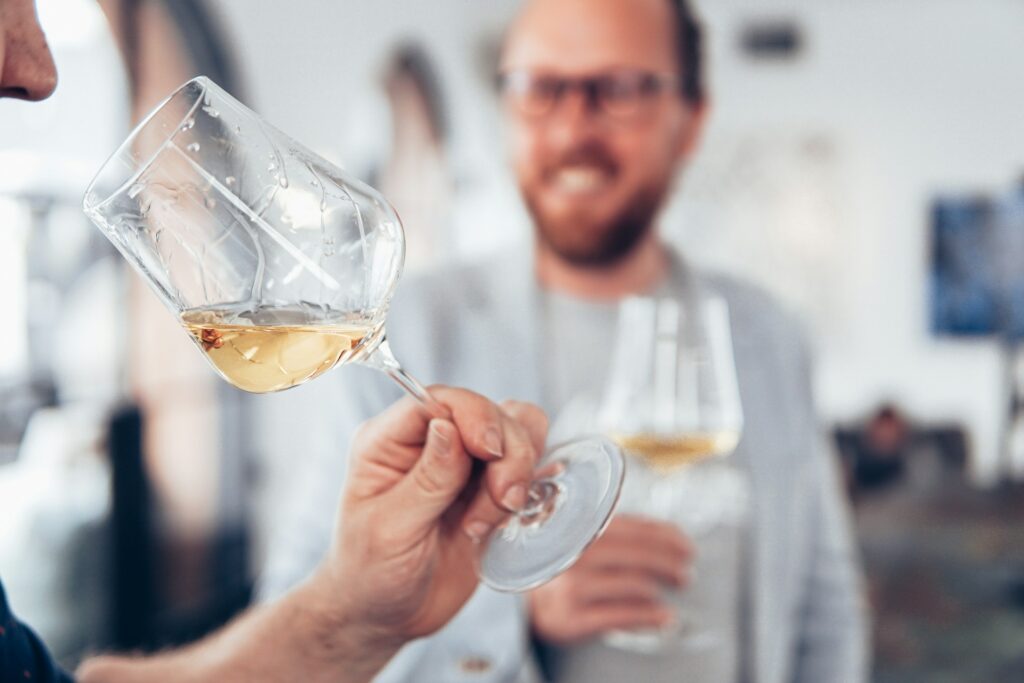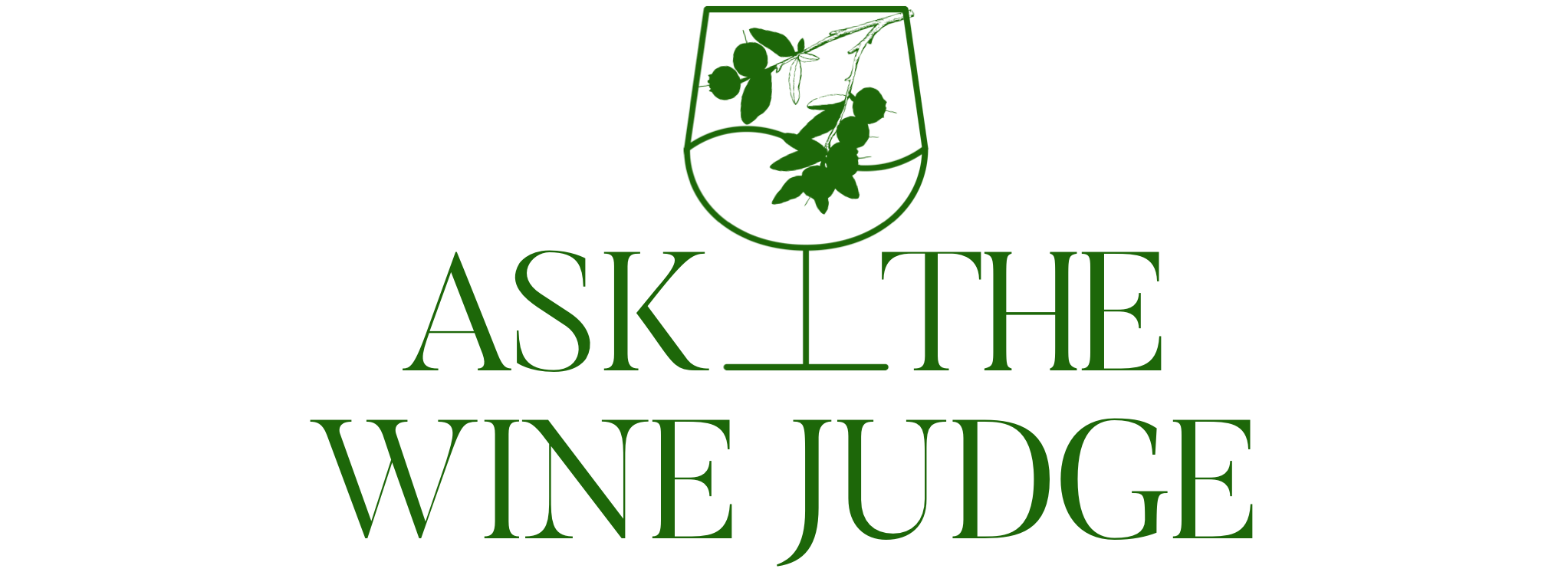Table of Contents
Have you ever noticed those mesmerizing tear-shaped drops gliding down the sides of a glass after you swirl your wine? In the world of wine, these are affectionately referred to as the ‘legs’ or ‘tears of wine.’ They’re more than just a visual delight; they’re a phenomenon that has intrigued wine lovers and sparked discussions in Napa Valley tasting rooms. But what do these elusive legs truly signify about the wine in your glass?
Science states that liquids with different surface tensions interact to create this effect. A thin film of liquid clings to the glass as you enjoy wine at a restaurant or home, and as the alcohol evaporates, the wine’s legs appear. But is there a deeper meaning behind these streaks, or has their significance been overstated through the ages? Let’s delve into the science and myths to uncover the truth about wine legs.
The Science Behind Wine Legs
In every wine glass, an invisible battle of forces takes place. The tears of wine materialize when the wine’s alcohol evaporates faster than water, causing the liquid to flow back down the glass in distinct drops. Gravity tries to pull the thin film of liquid down. The alcohol in the wine, with its lower surface tension, races up, creating curious drops. It is a physical manifestation of the liquids with different surface tensions working against each other to form the rivulets known as wine legs
Wine Legs vs The Marangoni Effect
While wine legs are a term of endearment in the wine community, they result from the Marangoni Effect—a fluid dynamics principle. This effect illustrates how liquids with different surface tensions flow in response to the tension gradient. In the case of wine, the alcohol’s lower surface tension causes it to rise up the sides of the glass, forming a band of liquid that leaves behind tear-shaped drops as it retreats.
However, the Marangoni Effect extends beyond the wine glass. It’s a broader scientific concept that explains the behavior of various liquids under different conditions. Wine legs are a specific instance of this effect in action, where alcohol’s evaporation and the wine’s surface tension differences come into a visually appealing play.
Do Legs Indicate Wine Quality?
External factors like the shape of the glass and room temperature can influence wine legs, not just the wine’s structural characteristics. While sweet wines or wines with higher alcohol content may show more pronounced legs due to a slower evaporation rate, this doesn’t necessarily hint at a wine’s quality.
As a seasoned wine enthusiast, I’ve heard countless theories about wine legs. Some say they indicate a wine’s quality, but in truth, they’re not a reliable gauge of excellence. Wine legs can tell us about the alcohol and sugar content but not much else. Judging a wine solely on its legs would be like assessing a book by the font used—it’s a small part of a much larger story.
So, the next time you see those streams running down your glass, remember that while they’re a charming part of the wine-drinking experience, they don’t hold the secret to a wine’s complexity or flavor profile. Let’s raise our glasses to the beauty of wine legs, but let’s not get carried away by the myths surrounding them.

Evaluating Wine Through Its Legs
Wine legs are just one part of the wine-tasting puzzle. While they offer a visual spectacle, they are not the sole indicators of a wine’s character. To truly evaluate a wine, one must look beyond the legs to the wine’s color, aroma, flavor, and finish.
What Can Legs Actually Tell Us?
When you swirl your wine and observe the legs sliding down the sides of the glass, you’re witnessing the wine’s viscosity. This can provide clues about the wine’s body, hinting at a fuller texture as seen in a strong Pinot Noir. But remember, wine legs are just the beginning of the story.
Understanding Viscosity and Texture
A wine that leaves thick, slow-moving legs may suggest a higher alcohol content or sweetness level, implying a certain richness or texture on the palate. But can we rely solely on this visual cue? Not quite. Viscosity is just one aspect of a wine’s profile and can be influenced by numerous factors such as winemaking techniques and grape variety.
Texture too is part of this equation. How a wine feels in your mouth—whether it’s silky, creamy, or perhaps even a bit grippy—is an essential sensory experience. Legs can hint at this textural complexity, but cannot define it. To fully grasp a wine’s texture, we must taste and savor it.
The Connection Between Legs and Wine Body
Have you ever wondered if the wine legs rolling down your glass have a story to tell about the wine’s body? A fuller-bodied wine, rich in alcohol and glycerol, might display more pronounced legs, suggesting a weightier, more substantial presence on your palate.
Legs as Part of the Tasting Experience
Observing wine legs can be a delightful part of the tasting experience, inviting us to slow down and appreciate the aesthetic qualities of a glass of wine. However, they are just an introduction to the senses that wine tasting offers.
Integrating Visual Cues With Taste and Aroma
When we pour a glass of wine, its legs are the first visual cue to catch our eye. As you let the wine breathe and open up, its aroma beckons, offering hints of fruit, earth, and spice. The first sip reveals the taste, confirming or defying the expectations set by the legs.
The legs of wine, while visually captivating, should be seen as a pretext to the full experience. By integrating these visual cues with the taste and aroma, we can appreciate the complexity and craftsmanship that goes into each bottle. So, what do your eyes tell you, and how does it compare to what your palate experiences?
The Folklore of Wine Legs
Throughout history, the legs of wine have been entwined with folklore, often seen as a sign of good fortune or a mark of a wine’s nobility. They have captivated the imaginations of wine lovers for generations, becoming a symbol of the mystique surrounding the art of winemaking.
Historical Perspectives on Wine Legs
In winemaking history, the concept of wine legs has long been a subject of fascination. Have you ever wondered how the ancients viewed those tears on the glass? They observed wine legs, considering them a sign of a wine’s richness and potency. Influenced by external factors such as climate and vinification methods, old-world winemakers would use the appearance of legs as a rudimentary gauge of alcohol content, which, in turn, impacted their crafting techniques.
How Wine Legs Influenced Old-World Winemaking
Within the storied cellars of the old world, the legs of wine were more than a curiosity—they were a barometer for a wine’s structural characteristics. Winemakers noted that sweet wines, with their higher sugar and alcohol levels, displayed more pronounced legs. Acknowledging this, they would tailor their fermentation processes to alter the evaporation rate and viscosity, seeking to craft wines with higher alcohol content that exhibited these desirable, slow-moving legs.
Contemporary Views and Wine Marketing
Today, the narrative of wine legs has evolved, intertwining with the art of wine marketing. The visual appeal of wine legs is often highlighted in descriptions, subtly suggesting a luxurious experience. B
When you read a wine label today, you might find allusions to the wine’s legs as a poetic descriptor. Marketers and sommeliers often use the term to evoke imagery of elegance and body. The first paragraph could explore how wine legs are portrayed in modern wine descriptions, using language that suggests grace and sophistication without making direct claims about quality. The second paragraph could delve into the way legs are used to communicate the wine’s texture and character, setting expectations for the sensory experience the wine will offer.
Practical Guide to Observing Wine Legs
Observing wine legs can be a delightful part of the wine-tasting experience. Whether you’re a seasoned wine aficionado or a curious beginner, how those clear streaks trickle down your glass after a swirl can be mesmerizing. But how do you ensure you’re seeing them correctly? Follow this practical guide to not just see but appreciate the legs of your wine.
Step-By-Step: How to See the Legs of Wine
So how do you form and spot those wine legs? Simply take your glass of wine, give it a gentle swirl, and watch as the legs form and flow.
Proper Glassware and Pouring Techniques
The right glass and pouring technique can make all the difference in observing wine legs. You’ll want a clean, clear wine glass, preferably tulip-shaped to concentrate the aromas. Pour in just enough wine to allow it to swirl—about one-third of the glass. This gives the wine ample surface area and air contact, setting the stage for the legs to appear.
The Swirl: Technique and Timing
Mastering the swirl is key to observing wine legs. Hold the base or stem of your glass and gently rotate your wrist to swirl the wine against the glass’s sides. This exposes the wine to oxygen, enhancing both aroma and the formation of legs. But how long should you swirl? Just a few seconds will do—enough to coat the glass but not so much that you’re left with a wine tornado.
Interpreting What You See
As you gaze at the legs forming, what do they tell you about your wine? While they’re not a definitive measure of quality, they can provide clues about the wine’s alcohol and sugar content. Wines with higher alcohol content, for example, tend to have more pronounced legs due to the difference in surface tension and evaporation rate. So, when you spot those legs, think of them as a window into the wine’s body and substance.

Frequently Asked Questions
There are plenty of questions about wine legs. Let’s walk through some of the most common inquiries.
1. Do wine legs indicate a better quality wine?
It’s a common belief that the more prominent the legs, the higher the quality of the wine. However, this isn’t necessarily true. Legs are more related to physics than to the finesse of the wine. They indicate the alcohol content and the evaporation rate but not the wine’s overall quality or complexity.
2. What causes wine legs to form?
Wine legs are the result of the Marangoni effect, where fluid moves from areas of lower surface tension to higher surface tension, and alcohol’s lower surface tension compared to water. As alcohol evaporates from the wine’s surface after swirling, it leaves behind a higher concentration of water, which climbs up the glass, forming legs as it flows back down.
3. Can you tell the alcohol content of the wine by looking at its legs?
Generally, wines with more pronounced legs have higher alcohol levels. The legs form because alcohol evaporates faster than water, creating a difference in surface tension. This effect is more noticeable in wines with higher alcohol content, so while not exact, you can get a rough idea of the alcohol levels by observing the legs.
4. Are wine legs more prominent in certain types of wines?
Yes, fortified wines or wines with higher levels of alcohol tend to display more pronounced legs due to their higher alcohol concentration. For example, a glass of rich, sweet port is likely to have more noticeable legs than a light, crisp Pinot Gris because of the difference in alcohol content in wine.
Concluding Thoughts on the Phenomenon of Wine Legs
As we wrap up our exploration, remember that wine legs are more than just a visual delight—they’re a doorway to understanding the fluid dynamics in your glass. Have you ever pondered why fortified wines exhibit more pronounced legs than their lighter counterparts? It’s all about the alcohol concentration and how it affects the evaporation of alcohol, creating those mesmerizing patterns. Whether swirling a glass of pinot gris or examining the contents in a wine bottle, the phenomenon of legs connects you to wine’s scientific and cultural fabric. Each glass tells a story, and the legs are a beautiful chapter we continue to admire and discuss.

Sed non elit aliquam, tempor nisl vitae, euismod quam. Nulla et lacus lectus. Nunc sed tincidunt arcu. Nam maximus luctus nunc, in ullamcorper turpis luctus ac. Morbi a leo ut metus mollis facilisis. Integer feugiat dictum dolor id egestas. Interdum et malesuada fames ac ante ipsum primis in faucibus.




